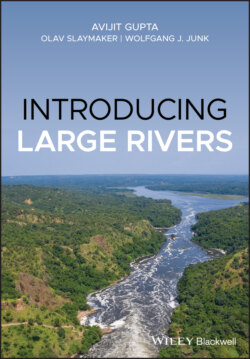Читать книгу Introducing Large Rivers - Avijit Gupta - Страница 16
2.3 Smaller Tectonic Movements
ОглавлениеThe basin and the channel of a big river are further modified by smaller tectonic disturbances. For example, the Lower Amazon crosses several transverse structures in its course (Figure 2.1). In the downstream direction these are the Iquitos Arch, Jutai Arch, Purus Arch, Mont Alegre Intrusion and Ridge, and Gurupa Arch. When the Amazon crosses such structural highs, certain geomorphic features characterise the river (Mertes and Dunne 2007). The channel runs straight, its floodplain remains relatively narrow, scroll bars are found only near channel margins, and migration of the channel is limited. In contrast, wide floodplains with significant river movement, scroll bars and anabranches distinguish the river flowing on a low gradient between the upwarps. Even when covered by an alluvial fill, these upwarps affect the river. The morphology of a large river therefore varies along its course.
Large-scale fractures also regionally affect the tributary network in the Amazon Basin. Deep-seated basement fracturing appears to have disturbed the overlying sedimentary rocks that affect the drainage net, oriented in northeast and northwest directions (Potter 1978, Figure 8 and references therein; Mertes and Dunne 2007). The alignment of the Lower Negro, one of the major north bank tributaries of the Amazon, has been interpreted as controlled by a NW-SE tectonic lineament (Franzinelli and Igreja 2002). Here sunken crustal blocks and depressions occur along a half-graben, submerged to approximately 20 m with a width of up to 20 km. This controls the pattern of river islands, bars, and the location of sediment storage in the river.
Figure 2.1 Schematic illustration of the relation between structure and morphology, the Lower Amazon Valley. The vertical bars show the approximate location of arches and a tilted block which are structural highs: JA, Jutai Arch; PA, Purus Arch; MI, Monte Allegro Intrusion and Ridge; GA, Gurupa Arch; TFB, approximate location of a tilted fault block.
Source: Mertes and Dunne 2007 and references therein.
Figure 2.2 Longitudinal profile of the Nile over varying regional structures and lithology.
Source: Woodward et al. 2007, from Said 1994.
A number of rivers flow along the structural grains of a folded mountain belt almost to their mouths. The Mekong and Salween are good examples. The Mekong flows for about 80% of its length in a narrow valley flanked by ridges (Figure 1.2a) whereas the Salween flows through a series of gorges. The lower Irrawaddy crosses three gorges in rock separated by wider basins in alluvium, and the morphology and behaviour of the river change between the gorges and basins. The entry and exit to the gorges show adjustment of the river over a short distance. The Irrawaddy finally continues through a flat lowland, discharging into the Gulf of Martaban through a large delta. The entire river is thus a sum of its different parts. The morphology and structural underpinning of large rivers are further discussed in Chapter 4.
Large rivers differ in their form and function, and for many rivers the understanding of such differences is achieved via a history of continental plate tectonics and lesser tectonic movements. The longitudinal profile of large rivers generally reflects a combination of their tectonic settings, basin lithology, and erosional history as their gradient changes (Figure 2.2). The profile of a large river over a long distance thus may be a combination of different sections. Geological structure and lithology tend to control the basic characteristics of the rivers.
